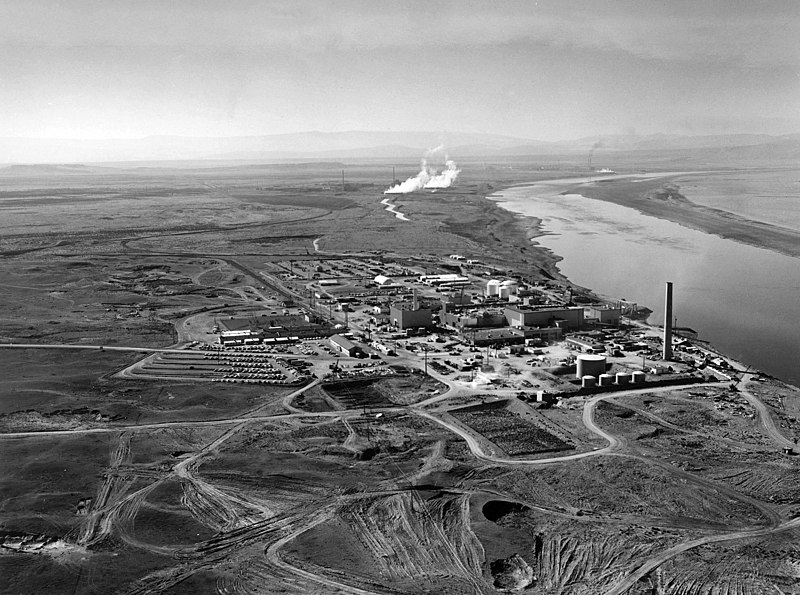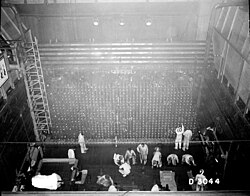sgp.fas.org/othergov/doe/pu50yc.html mentions:That site also contains a good summary of the closed shutdown reactors in each site. These are publicly disclosed e.g. at: www.hanford.gov/page.cfm/ProjectsFacilities
The United States Government has used 14 plutonium production reactors at the Hanford and Savannah River sites to produce plutonium for the U.S. nuclear weapons stockpile and DOE research and development programs. From 1944 to 1994, these reactors produced 103.4 metric tons of plutonium; 67.4 MT at Hanford, and 36.1 at Savannah River.
www.youtube.com/watch?v=qwKhz7BPBLY mentions that before they stopped production at the end of the Cold War, Hanford site produced 2/3 of the total American stockpile, and Savannah River site produced 1/3.
www.reuters.com/article/world/americas-nuclear-headache-old-plutonium-with-nowhere-to-go-idUSKBN1HR1JT/ claims that as of 2018 Savannah River site stored the majority of the stockpile.
Bibliography:
nct-cbnw.com/americas-new-nukes-plutonium-pits-at-los-alamos/
After the closure of the country’s prime plutonium manufacturing plant at Rocky Flats in 1992, where 1,000 to 2,000 pits were produced every year, a highly reinforced 236,000 sq-ft facility built at LANL earlier in 1978 became the first Department of Energy (DoE) facility capable of producing plutonium cores.Although initially established for plutonium research and development, in 2003 the Plutonium Facility Building 4 (PF-4) within Tech Area 55 at Los Alamos produced the nation’s stockpile quality (first war reserve) plutonium. In 2006, Congress instructed the DoE to focus on producing pits at this facility.
The B Reactor of the facility produced the plutonium used for Trinity and Fat Man, and then for many more thousand bombs during the Cold War. More precisely, this was done at
Located in Washington, in a dry place the middle of the mountainous areas of the Western United States, where basically no one lives. The Columbia river is however nearby, that river is quite large, and provided the water needed by their activities, notably for cooling the nuclear reactors. It is worth it having look on Google Maps to get a feel for the region.
Unlike many other such laboratories, this one did not become a United States Department of Energy national laboratories. It was likely just too polluted.
Bibliography:
This was the first full scale nuclear reactor in the world, and was brought up slowly to test it out.
Hanford B Reactor tour by Studio McGraw
. Source. 2016.- youtu.be/8rlVHEY7BF0?t=335 good description of the fuel element. It uses uranium metal, not Uranium dioxide
- youtu.be/8rlVHEY7BF0?t=652 N Reactor and F Reactor were identical, and came up 2 months later, but much faster because of what they learned on the B
This was one of the two American plutonium production sites, together with the Hanford site. www.youtube.com/watch?v=qwKhz7BPBLY mentions it produced about 1/3 of the total American plutonium.
www.reuters.com/article/world/americas-nuclear-headache-old-plutonium-with-nowhere-to-go-idUSKBN1HR1JT/ claims that as of 2018 it stored the majority of the plutonium stockpile of the country.
It's where most American nuclear weapons are assembled and disassembled.
Dismantlement of Nuclear Weapons by Sandia National Laboratories
. Source. Great video, shows everything that is not classified.Historic, unique Manhattan Project footage from Los Alamos by Los Alamos National Lab
. Source. Mostly the daily life part of things, but very good, includes subtitles explaining the people and places shown.
Marked with identifier "LA-UR 11-4449".
Getting funding for the Chicago Pile Edward Teller interview by Web of Stories (1996)
Source. - youtu.be/mnScq24BEmc?t=114 the main cost for the reactor was the graphite. Presumably they already had the uranium in hand?. Edit, no, it is because it was a specialized graphite: Video 2. "German graphite from The Genius Behind the Bomb (1992)", i.e. nuclear graphite.
German graphite from The Genius Behind the Bomb (1992)
Source. Graphite was expensive because it had to be boron-free, since boron absorbs neutrons. But a boron process was the main way to make graphite. This type of pure graphite is known as nuclear graphite.The lab that made Chicago Pile-1, located in the University of Chicago. Metallurgical in this context basically as in "working with the metals uranium and plutonium".
Given their experience, they also designed the important X-10 Graphite Reactor and the B Reactor which were built in other locations.
Plutonium-based.
Its plutonium was produced at Hanford site.
Trinity: Getting The Job Done
. Source. Good video, clarifies several interesting technical points:- Gun-type fission weapon were much easier to build as you don't need super synchronized charges as in implosion-type fission weapon. But they are less efficient.
- Plutonium make much more efficient usage of uranium, because you don't need to highly enrich a bunch of Uranium-235 in the first place, but rather just use way less enriched Uranium-235 to produce a bunch of Plutonium by converting Uranium-238
Articles by others on the same topic
There are currently no matching articles.




